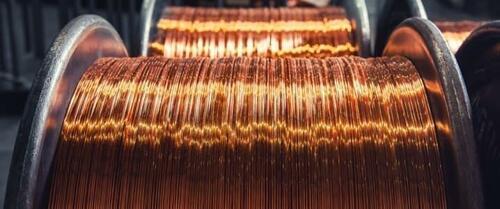
By Haley Zaremba of OilPrice.com
“Think of copper as a common carrier, so to speak, of decarbonization. It is literally the wiring that connects the present to the future,” writes Nathaniel Bullard, BloombergNEF's Chief Content Officer. While many of us imagine renewable energies to be just that – infinitely renewable, with no use of finite resources – the reality is that solar planes, wind turbines, energy transmission infrastructure, batteries for energy storage, and motors for your electric cars and electric bicycles all rely on metals that are not infinitely sourceable. Much lip service has been paid to the extraction and exploitation of lithium to power electric vehicle batteries, but one could argue that copper is even more central to – and therefore potentially threatened by – a large-scale green energy transition.
The reverse is also true – a looming copper shortage threatens to completely derail the clean energy transition, and by extension, climate pledges across the world. According to a recent report from S&P Platts, if copper shortfalls follow projected trends, climate goals will be “short-circuited and remain out of reach.”
Copper is particularly effective in a wide range of low-carbon alternatives because of its relatively high electrical conductivity and low reactivity. It’s not that traditional energy production and transmission and gas-powered vehicles don’t use copper in their manufacturing – it’s just that renewables and electric vehicles require a whole lot more of it. “An EV requires 2.5 times as much copper as an internal combustion engine vehicle,” reports CNBC. “Meanwhile, solar and offshore wind need two times and five times, respectively, more copper per megawatt of installed capacity than power generated using natural gas or coal.”
Copper production is already struggling to keep up with booming demand, and S&P projects that current levels of demand will nearly double by the year 2035, climbing to a whopping 50 million metric tons. That figure will climb to more than 53 million metric tons by 2050, which amounts to “more than all the copper consumed in the world between 1900 and 2021.” BloombergNEF’s projections are a bit more conservative, but still striking, finding that copper demand will increase by over 50% by 2040. Worryingly, the same report projects that primary copper production can increase by just 16% in the same time period.
This damning differential does not necessarily mean, however, that the world will be “structurally short of copper” for the next 18 years. It is likely that the economics of the copper deficit will suppress demand due to prohibitively high prices, ultimately helping to balance out the supply deficit. “That would happen, however, at the expense of expansions of clean power and electrified transportation,” reports Bloomberg.
What the world needs – today’s world as well as the future, increasingly climate-threatened one – is a bigger emphasis and greater expenditures on copper discovery and exploration. Considering copper’s central role in the essential public project of climate change mitigation and adaptation, the public sector should be as active as the private sector in facilitating more, cheaper, and lasting primary copper production. This should be paired with robust copper recycling and recovery programs.
Secondary copper production – essentially, recycling copper – is already a strong and well developed economic sector, completely filling the “4.6 million-ton-per-year gap between primary production and demand” with industrial copper scrap. But there is a huge opportunity – and indeed, imperative – to improve copper scrap collection from consumers. Currently, the copper collection rate from consumer and electronic goods stands at just 53%. As copper becomes increasingly scarce and increasingly expensive, the economics of better copper recovery will likely encourage far greater recovery in this respect, making copper not only better suited to support renewable, but more renewable itself.
By Haley Zaremba of OilPrice.com
“Think of copper as a common carrier, so to speak, of decarbonization. It is literally the wiring that connects the present to the future,” writes Nathaniel Bullard, BloombergNEF’s Chief Content Officer. While many of us imagine renewable energies to be just that – infinitely renewable, with no use of finite resources – the reality is that solar planes, wind turbines, energy transmission infrastructure, batteries for energy storage, and motors for your electric cars and electric bicycles all rely on metals that are not infinitely sourceable. Much lip service has been paid to the extraction and exploitation of lithium to power electric vehicle batteries, but one could argue that copper is even more central to – and therefore potentially threatened by – a large-scale green energy transition.
The reverse is also true – a looming copper shortage threatens to completely derail the clean energy transition, and by extension, climate pledges across the world. According to a recent report from S&P Platts, if copper shortfalls follow projected trends, climate goals will be “short-circuited and remain out of reach.”
Copper is particularly effective in a wide range of low-carbon alternatives because of its relatively high electrical conductivity and low reactivity. It’s not that traditional energy production and transmission and gas-powered vehicles don’t use copper in their manufacturing – it’s just that renewables and electric vehicles require a whole lot more of it. “An EV requires 2.5 times as much copper as an internal combustion engine vehicle,” reports CNBC. “Meanwhile, solar and offshore wind need two times and five times, respectively, more copper per megawatt of installed capacity than power generated using natural gas or coal.”
Copper production is already struggling to keep up with booming demand, and S&P projects that current levels of demand will nearly double by the year 2035, climbing to a whopping 50 million metric tons. That figure will climb to more than 53 million metric tons by 2050, which amounts to “more than all the copper consumed in the world between 1900 and 2021.” BloombergNEF’s projections are a bit more conservative, but still striking, finding that copper demand will increase by over 50% by 2040. Worryingly, the same report projects that primary copper production can increase by just 16% in the same time period.
This damning differential does not necessarily mean, however, that the world will be “structurally short of copper” for the next 18 years. It is likely that the economics of the copper deficit will suppress demand due to prohibitively high prices, ultimately helping to balance out the supply deficit. “That would happen, however, at the expense of expansions of clean power and electrified transportation,” reports Bloomberg.
What the world needs – today’s world as well as the future, increasingly climate-threatened one – is a bigger emphasis and greater expenditures on copper discovery and exploration. Considering copper’s central role in the essential public project of climate change mitigation and adaptation, the public sector should be as active as the private sector in facilitating more, cheaper, and lasting primary copper production. This should be paired with robust copper recycling and recovery programs.
Secondary copper production – essentially, recycling copper – is already a strong and well developed economic sector, completely filling the “4.6 million-ton-per-year gap between primary production and demand” with industrial copper scrap. But there is a huge opportunity – and indeed, imperative – to improve copper scrap collection from consumers. Currently, the copper collection rate from consumer and electronic goods stands at just 53%. As copper becomes increasingly scarce and increasingly expensive, the economics of better copper recovery will likely encourage far greater recovery in this respect, making copper not only better suited to support renewable, but more renewable itself.





